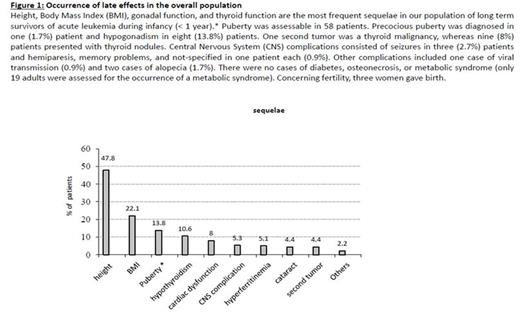Abstract
Purpose
The long-term impact of treatment in infants with acute leukemia (AL) is poorly understood and of concern.
Patients and methods
We analyzed the incidence, in the L.E.A. cohort, of and risk factors for late sequelae in the survivors of infant AL diagnosed before the age of one year, according to group: type of AL, transplantation, sex, and age ≤ or > 6 months. Of 113 survivors, 55 had had lymphoblastic AL and 58 myeloblastic AL. The median follow-up was 11.7 years [1.9-34.7]. Sixty-three were treated with chemotherapy only (and four with central nervous system irradiation) and 50 received transplantation (with a chemotherapy-based regimen except for three).
Results
The most frequently observed sequelae included problems of height, body mass index, and gonadal or thyroid function (Figure 1). We found a mean of 1.3 +/-0.1 sequelae per patient. In multivariate analysis, treatment after the age of six months significantly decreased the incidence of major growth failure (OR 0.38, p = 0.04) and low weight (OR 0.3, p = 0.02) (Figure 2). Transplants performed in first remission did not affect the occurrence of late effects (p = 0.2) (Figure 3). Parent-reported child quality of life (QoL) scores were similar among groups and to the normative population. Adults had diminished QoL as measured by psychosocial subscales relative to French norms but with no difference between groups.
Conclusion
Altogether, these results highlight the need for comprehensive follow-up with hormone replacement therapy and psychological intervention. Our results in a large cohort with very limited use of irradiation, did not show an increased risk of late sequelae relative to older children. We conclude, that transplantation should be considered when warranted, as there is no increased risk of late effects.
No relevant conflicts of interest to declare.
Author notes
Asterisk with author names denotes non-ASH members.



This feature is available to Subscribers Only
Sign In or Create an Account Close Modal